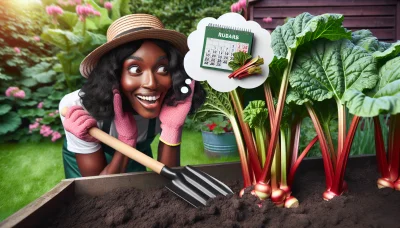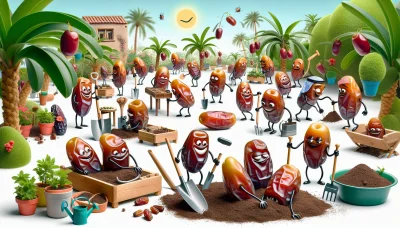Raw dates Quiz
Test Your Knowledge
Question of
The Benefits of Growing Raw Dates
Growing raw dates in a garden offers a multitude of nutritional and environmental benefits. Nutritionally, dates are a powerhouse of energy, packed with natural sugars, fiber, and essential vitamins and minerals such as potassium, magnesium, vitamin B6, and iron. This makes them an excellent natural sweetener and a healthy addition to any diet. From an environmental perspective, date palms are remarkably resilient and can thrive in arid environments, contributing to soil stabilization and providing a habitat for a variety of wildlife. They require relatively little water compared to other fruits, making them an ideal crop for sustainable gardening practices. By incorporating date palms into gardens, individuals can enjoy not only the nutritional benefits but also contribute positively to environmental conservation.
Choosing the Right Variety for Your Garden
When it comes to planting date palms, selecting the right variety is crucial for ensuring a thriving garden. Different varieties of date palms are suitable for various climates and soil types. For instance, the Medjool variety, known for its large and sweet fruits, prefers hot, dry climates and well-draining soil, making it an excellent choice for arid regions. On the other hand, the Deglet Noor variety, which produces less sweet but highly versatile fruits, can tolerate slightly cooler climates and a wider range of soil types. It's important to research and consider the specific needs of each variety, including water requirements, sunlight exposure, and temperature tolerances, to select the best date palm for your garden's unique environment.
Step-by-Step Guide to Planting Date Palms
- Select the right spot in your garden that receives full sunlight for most of the day.
- Ensure the soil is well-draining; sandy loam is ideal for date palms.
- Check the pH of the soil; date palms prefer a pH of 6 to 7.
- Prepare a large hole, about twice the width and depth of the root ball of your date palm.
- Mix some organic compost with the soil you removed to help enrich the planting area.
- Remove the date palm from its container and gently tease out the roots if they are pot-bound.
- Place the date palm in the center of the hole, ensuring it's standing straight.
- Backfill the hole with the amended soil, tamping down lightly to remove air pockets.
- Water the date palm generously immediately after planting to help settle the soil.
- Mulch around the base of the palm with organic material to help retain moisture and suppress weeds.
- Water the date palm deeply once a week, allowing the soil to dry out slightly between waterings.
- Apply a palm-specific fertilizer during the growing season to support healthy growth.
Caring for Your Date Palms
To ensure your date palms thrive, it's crucial to follow a few essential care tips. First, watering is fundamental; date palms require deep, infrequent watering to mimic their natural arid environment. This helps in developing a strong root system. Secondly, pruning is necessary to remove dead or damaged fronds and to maintain the tree's shape and health. It's best done in the late winter or early spring. Lastly, pest control is vital for the health of your date palms. Regularly inspect for signs of pests and diseases and treat them promptly to prevent spread. By adhering to these care tips, your date palms will grow healthy and strong.
Common Pests and Diseases Affecting Date Palms
- Red Palm Weevil: This pest bores into the trunk, weakening and eventually killing the palm. Management includes removing infested trees, using pheromone traps, and applying insecticides.
- Bayoud Disease: A fungal disease that causes wilt and death in date palms. Management practices include using disease-free planting material and removing and destroying infected palms to prevent spread.
- Dubas Bug: A sap-sucking insect that affects the vigor of the palm. Control methods include the use of oil sprays and systemic insecticides.
- Leaf Spot Diseases: Caused by various fungi, leading to spots on leaves and reduced photosynthesis. Fungicide applications and removal of affected leaves can help manage these diseases.
- Root Rot: Often caused by overwatering and poor drainage, leading to decay of the roots. Management includes improving soil drainage and avoiding overwatering.
Harvesting and Storing Raw Dates
Harvesting raw dates requires timing and technique to ensure they reach peak ripeness without damage. The best practice is to wait until the dates are fully ripe, which is indicated by a deep brown color and slightly soft texture. Use a sharp, clean cutting tool to detach the clusters from the palm to avoid harming the tree and the fruit. For storage, raw dates should be kept in a cool, dry place away from direct sunlight. Sealing them in airtight containers or zipper bags can significantly extend their freshness. Refrigeration is recommended for long-term storage, where they can last for several months. Properly harvested and stored, raw dates can maintain their quality and nutritional value, making them a delicious and healthy treat any time of the year.
Delicious Recipes Using Raw Dates
| Recipe Name | Ingredients | Preparation Instructions |
|---|---|---|
| Date Smoothie | Raw dates, banana, almond milk, cinnamon | Blend all ingredients until smooth. Serve chilled. |
| Stuffed Dates | Raw dates, goat cheese, walnuts | Split dates in half, remove pits, fill with goat cheese, top with a walnut. |
| Date Energy Balls | Raw dates, oats, flax seeds, peanut butter | Mix ingredients in a food processor. Roll into balls and refrigerate. |
| Chocolate Date Bars | Raw dates, almonds, cocoa powder, coconut oil | Process all ingredients until sticky. Press into a pan, chill, and cut into bars. |












